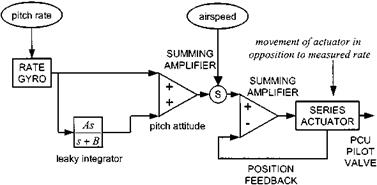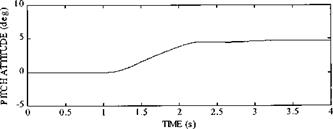Rate command and short-term attitude hold
If integrated rate is used then enhanced gust rejection can be expected, as even small angular rates will, over a period of time, generate sizeable attitude errors. However if the pilot moves the control to a new position then, within the authority of the series actuator and all the time an angular rate is present, the AFCS will attempt to drive the attitude back to that occurring before the input was made. One solution to this problem is to arrange for the attitude error signal to ‘leak away’ with time (Fig. 6.19). Thus if the pilot makes a deliberate control input the AFCS will, after a short period of time, take the current attitude as the one about which to hold. Applying an aft pulse (Fig. 6.20), shows a leaky integrator’s effect on the handling qualities. Application of the pulse indicates that the SAS is capable of holding an attitude, selectable by the pilot, for a short period.
|
|
|
|
|

Another solution to unwanted retention of pseudo-attitude hold is simply to switch it off when it is not required. This can be achieved by installing microswitches that disconnect the integrated rate signal when the stick is in motion. When stick movement has ceased the hold can be re-engaged and divergence from the attitude prevailing at that instant will cause movement of the series actuator. Re-engagement of the signal is often dependent on a low rate signal being sensed, 2 degree/second, for example, as well as the lack of any stick movement. The gust response of such a SAS is shown in Fig. 6.21. From this figure it would appear that a satisfactory solution can be achieved as the long-term attitude hold seems reasonable.
It must be remembered, however, that if the attitude signal has been derived from the rate gyro any drift or noise occurring within the rate gyro will compromise the attitude signal thus reducing the effectiveness of the attitude hold. Figure 6.22 shows
|
|
|
Fig. 6.22 Gust response of SAS with noise and drift on rate gyro signal. |
the result of including realistic levels of noise into the rate signal causing a deterioration of the attitude hold as expected.
In summary, we can characterize stability augmentation via rate and integrated rate feedback, with the pseudo-attitude signal either allowed to leak or being disabled during manoeuvres, as a system that provides rate command and short-term attitude hold.















